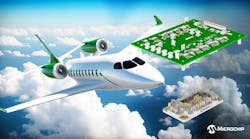By John McHale
SAN DIEGO — Experts at Z-Microsystems in San Diego say military systems designers are turning away from basic rugged commercial-off-the-shelf (COTS) products and toward mil-spec COTS products like their 20R Display for an aircraft surveillance application.
Z-Microsystems officials are unable to comment further on the application because they say it is classified.
"Government designers buy the 'latest and greatest' technology in their development labs which rolls out first in the commercial market," says Vladimir Rogov, vice president of industrial design at Z Microsystems.
"The initial requirements of these designers are for COTS since that's what they are using in their labs," he says. "But, when it's time to deploy this equipment for mission-critical applications, they have found out the hard way, that it breaks when it is sent out in the field. Program integrators have discovered that regular COTS equipment that is intended for office desktops breaks in rough environments.
"The military's 'Buy COTS!' mantra is sound advice for labs and offices, but not for mission-critical or deployed operations," Rogov continues. "Furthermore, no one panel can fit all applications. At this count, we have 18 different models serving applications ranging from helicopters where vibration and weight is a big issue, through aircraft, unmanned aerial vehicles, varying ground vehicles, ships, submarines, and so on — all with their special conditions. That's why we call all our products 'Field-Ready'. They come out of the box and go directly into a field application."
Z Microsystems Orion display is one example of a mil-spec product available off the shelf, he says.
"The military is assessing the applications for flat-panel displays across a broad front," Rogov explains. "Retrofitting old, outdated [cathode ray tubes] with flat-panel displays taking into consideration their inherent weight, power, heat, and volume savings is foremost in selection criteria. These savings translate into increased platform performance, for instance, where aircraft can stay on station longer due to reduced weight and tracked vehicles can reduce critical generator size due to significantly lower power requirements. Therefore, flat-panel displays are also being implemented on new programs as well."
The active-matrix Orion 20R liquid-crystal display (LCD) complies with military standards, he says. Its lightweight aluminum construction is designed for shipboard, airborne, and field deployments, Z Microsystems officials say.
Each display features MIL-STD connectors, an optional surface acoustic wave touch screen, and handles. Front panel on-screen controls enable easy monitor adjustment and variable-speed fans maintain even airflow as the monitor temperature rises from 30 to 50 degrees Celsius.
The display's operational temperature range is from zero to 50 degrees C and its non-operating temperature range is from -40 to 70 degrees C, Rogov says. It has an operating altitude of 11,500 feet and 42,000 feet for non-operating altitude. The Orion 20R also meets MIL-STD 167 for vibration, MIL-STD 810E and MIL-STD 901D Grade A Class II for shock, and MIL-STD 461C for EMI.
Dealing with obsolescence issues is another challenge of COTS, Rogov says. "The obsolescence problems with COTS displays are in the LCD components themselves," Rogov says. "As there are only half a dozen manufacturers of LCD's in the world, and they focus on the commercial market, their products have a life cycle of about six months.
"This is good and bad for the military," he explains. "The quality improves as well as the prices fall with each new offering, which is good. However, the suppliers keep changing the physical footprint, components, and interface, which is bad."
Z Microsystems engineers separate the LCD glass from the controller, Rogov says. "That's why, we are able to quickly and transparently roll new LCD panels into our display products without changing the packaging and external interface to the user. This means that the customer's logistics, documentation, and training requirements aren't going to change every time the COTS world changes models. By having a continuing program of controller development we make the technology changes transparent. The user interaction items become stable and familiar while the science keeps getting better."
By developing their own controllers Z Microsystems engineers are also able to provide a higher-quality image and use additional features needed in military applications such as night vision, multi-display color balancing, modulation of fans and heaters, etc., Rogov says.
Z Microsystems flat-panel displays are being used in sonar, communications, reconnaissance, gunfire control, mine sweeping, tactical operations, command and control, maintenance, integrated bridge, fuel control, test equipment and various other applications on fixed- and rotary-wing aircraft, subsurface and surface ships, tracked vehicles, tanks, and in shelters, Rogov says. The company is also seeing interest in their products from "prisons, fire services, law enforcement, and crisis management forces," he adds.
For more information on the Orion displays and Z Microsystems contact Vladimir Rogov by phone at 858-657-1000, by fax at 858-657-1001, by mail at 5945 Pacific Center Blvd., Suite 509, San Diego, Calif. 92121-4309, by email at [email protected], or on the World Wide Web at http://www.zmicro.com.


